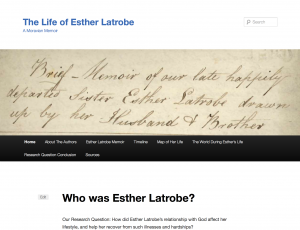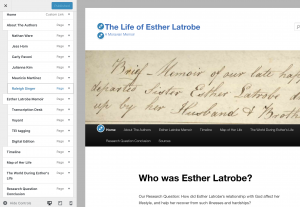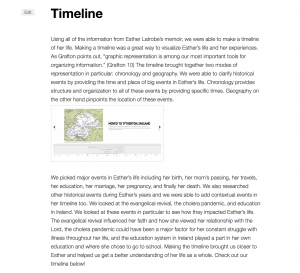For the first step in me and Jacob’s final project on John Willey, we chose to research how much agency he Willey had in his life. My first time reading through John Willey’s memoir, I read through i quickly and noticed he was very busy with his religious work. I assumed he was always very passionate about it, but as we looked at the memoir through other tools and working with it all semester I learned Willey didn’t always have a great sense of agency in his life. When you dig deeper into his memoir, it shows that his work was often pressured on him by his family or his church. Through looking at our timelines, story maps, relationship entities, and a couple outside sources we were able to determine where Willeys agency came from.
Before we actually began our final project, we had the opportunity to work on a snap talk, which was a great first step towards answering our research question. For this project, we developed an outline of Willey’s entire memoir, making sure we had all the information fresh in our minds as we worked on our final project. Additionally, we compiled all the resources and tools we could use to find Willey’s agency. Then we looked into each of those methods more to determine how exactly we can use them. This was where our deeper research came in, and we began our final project to determine how Willey’s agency in his life is influenced.
One helpful secondary source in answering our research question was Professor Faull’s book, Speaking to Body and Soul. This book taught us a lot on how Moravian Church determines the decisions you make in life. There is process which your decisions are made by a Bible verse you put into a box named the lot. Another helpful secondary source was the Yorkshire Families M-Z – 18th Century list, providing background info on Willey’s family. This source had his family listed out, providing information on their occupations, Church orders, education, Church service, etc. John Willey’s father, Michael Willey, and his mother, Abigail Willey were both extremely involved in the Church, leading me to believe that John Willey did not really have much choice but to be religious. Enhancing this idea was a quote I found in Willey’s memoir, stating that When John Willey was 21 his “father became laborer of Kingwood congregation about that time, he was frequently with him there assisting in the school in that place. It was here he was viewed with the Congregation” (4). Shortly after that, Willey received his First Communion, and began his involvement in the Church. I feel that had John Willey not been surrounded by his Father’s religious work he wouldn’t have went down that path, showing his agency in his life didn’t come from his own choices.

Through looking at our relationship entities that we developed using Oxygen, we were able to notice relationship between where a person went and why they went to that place. We also compared that with dates, showing us how frequently Willey was moving around throughout his life. He only lived in each place for a short period of time, and each was for a religious job. He was happy in some places and wanted to stay but wasn’t allowed to. And even as his health declined, and Willey begged “dismissal from active Service in Cootehill” (Wiley memoir, 13), he was forced to stay involved in the Church. Willey was suffering and had no agency for his work at this time, yet he was forced to continue his work.

Another representation of how Willey’s life was determined by the Church came from our story map. As Bodenhamer suggests, “all spaces contain embedded stories based on what has happened there” (16). Therefore, to truly understand Willey’s life, we have to notice where he was from. Our story maps showed us that Willey moved a great distance over the course of his life. He grew up in the United Kingdom, then was forced by the Church to move to Northern Ireland, never able to return back home. Willey was very happy with many of his jobs, but was forced by the Church to constantly move. This lead to Willey’s eagerness to work to lessen, weakening his agency towards his work. Additionally, many of the areas Willey went to were extremely religious, enhancing his pressure to work in the Church. Also, John Willey was forced by the Church to move to Northern Ireland, which was disease-ridden at the time, perhaps contributing to John Willey’s illness, which ultimately ended all agency for him.

One major difficulty Jacob and I encountered was actually developing our WordPress site. Unfortunately, we lost one of our group members in the last couple weeks, who had experience using wordpress. But neither me or Jacob were familiar with it. Luckily, our Professors were extremely helpful with creating our wordpress site. We have multiple pages, each depicting how a tool we used helped us to answer our research question. Additionally, we have our research question outlined, some background on the Moravian Church, the process of our project, and some background on Willey’s memoir. This is all online on a very interactive and accessible wordpress web site titled “The Life of John Willey” I am happy with how our design turned out, and think our site does a great job of answering our research question.

Overall, I think my studies this semester have been extremely helpful in developing my group work skills, knowledge on Moravian Lives, as well as learning a lot of knowledge about Digital Humanities. As Whitley reading states, we are able to “discovery of the knowledge these archives contain.” I feel I was able to discover a lot of the knowledge in Willey’s memoir through the process of this class this semester. Additionally, I was able to learn and develop my skills with many valuable resources, such as voyant, wordpress, oxygen, and many others. The process of learning about John Willey’s memoir has been a great experience.
Tyler George is a political science and history double major at Bucknell University in Lewisburg, Pennsylvania. Tyler formerly attended Lincoln-Sudbury high school, in his hometown, Sudbury, Massachusetts. Tyler plays club hockey at Bucknell, and also participates as an Army ROTC cadet in the Bison Battalion.









